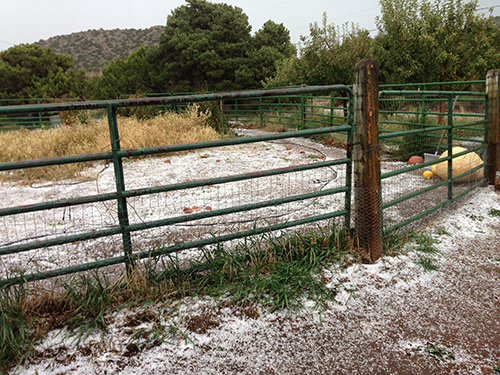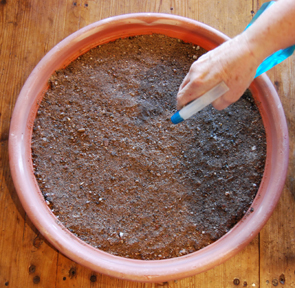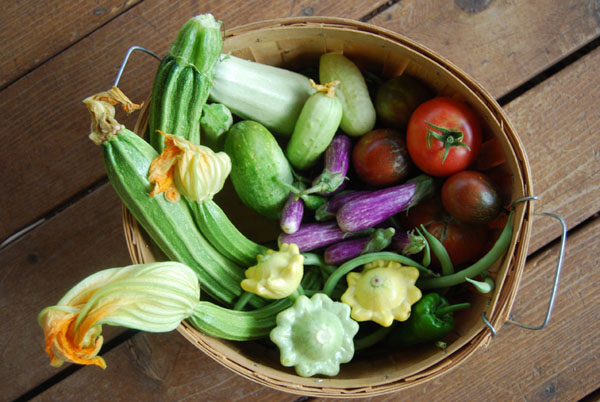
Yesterday’s hail storm-October 11, 2013
This has been one of the most challenging years in the veggie garden that I can remember.
First the leafhoppers arrived in spring to infect the tomato plants with the curly top virus they carry, a fatal disease for tomato plants. They particularly get bad during drought years because they like it dry and hot. I pretty much thwarted them by covering all but 4 of my tomatoes with row cover (I ran out) which acts as a physical barrier until they left in July when the rains came. So my loss was minimal-maybe 10% compared to the 50% loss of tomato plants last year for me. Luckily I always grow more than I need. I will definitely will cover them again next year.

Biggest pumpkin ‘Honey Boo Boo’ only 176 lbs at end
A squirrel ate my best and fastest growing giant pumpkin plant which put me out of commission to be a contender for our state record, putting me 2 months behind when growing the back-up pumpkin. Here is a pic with my total pumpkins-biggest this year-named ‘Honey Boo Boo’ – 176 lbs-bummer…
We had one of the worst hail storms I can remember in early July but again since the tomato plants were still covered, they were protected. Everything else really got set back but did come back eventually. Many of my gardener friends got hit really hard and lost many crops in that one storm.

Hail damage-tomato on left, cracks (now healed) from too much water tomato on right
Then in August we finally started getting a lot rain which we desperately needed. Unfortunately we got 3 inches of rain in one week which the plants couldn’t handle all at once and many, including rock hard green ones split or cracked from too much water. (Ahh, whata ya going to do? First too little water, then too much water all at once!) The tomatoes were a little watery for about a week until they absorbed the extra water and healed their cracks. Now they are good again. Most of the uglies became sauce.
Then another devastating hailstorm this time with the row cover off so the tomato plants took it hard and many started to succumbed to fungal diseases because the hail damage weakens the plants and makes them susceptible. Kinda like us getting a severe beating opening up many wounds.

Hard freeze in late September finished off tomatoes
While I was on vacation, we got our first hard freeze in the last week of September which basically finished off the garden except for the chard and the grass growing under the tomato plants. Pretty unbelievable that we got such an early freeze in Sept when usually it doesn’t come till the second or third week of October. So the season has ended up very short. Usually I can go to the Farmers Market through the first week of November now I’m not sure I can get thru the 3rd week of October. I will go tomorrow to the market as I still have 8 boxes of good tomatoes but we will see after that. I just picked the green ones that were starting to ripen and see if they will still ripen.

Pumpkin patch almost cleaned up before hail hit.
And finally yesterday we had another hail storm-in October no less! Unheard of to have hail so late. Luckily I had finished picking any tomatoes, eggplants, peppers and a few squash that made it just yesterday morning before the hail hit. So that’s it-THE END. (although I think I may still have some chard left-gotta see how beat up it got…)
Which brings up a point as I am rather calm about all this. I use to get super upset but I learned 11 years ago when we had our 3 year bark beetle infestation due to a severe 4-year drought that basically wiped out 98% of our pinon trees (I lost 300) that we really can’t fight Mother Nature. We can only beat our heads against the wall for so long. We try to do our best and then at some point I learned that I just have to surrender to what is—’you can’t stop an avalanche’ as I was told once. Once I surrender, all stress leaves because I realize I can only do what I can do and that’s it. And surrendering is not so bad as now I can let go and start to plan the next season. Ahh, the life of a little farmer. Luckily my main income comes from glassblowing not farming so I am very lucky in that sense compared to the farmers whose main income is from their crops.
Besides I haven’t been able to write that much in the blog this season as I’ve been so busy in the garden but I did take pics and can catch up on some of the things that took place but didn’t have time to write about. Stay tuned…




























